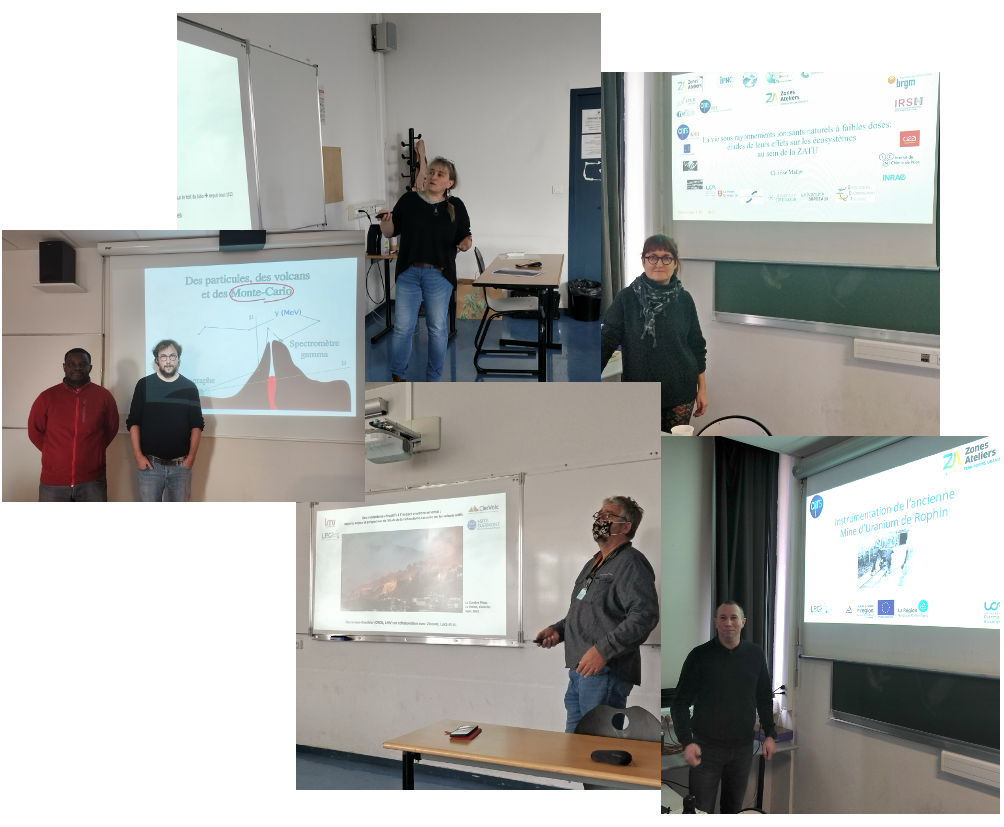Seminars

• April 8, 2025: Instrumentation and modelisation for advanced radiotherapy techniques, PDF
Jayde Livingstone, assistant lecturer, Laboratoire de Physique Subatomique et de Cosmologie, Université Grenoble Alpes
Radiotherapy is a key treatment modality for cancer, aiming to deliver a lethal dose to malignant cells while minimising damage to surrounding healthy tissues. Advanced and emerging radiotherapy techniques, such as hadron therapy, spatially fractionated radiation therapy (MRT), and ultra-high dose rate irradiation (FLASH), seek to enhance this therapeutic effect by improving tumour targeting and reducing toxicity to normal tissues. Hadrontherapy takes advantage of the unique dosimetric properties of charged particles, such as protons and heavier ions, promising to precisely target tumours whilst avoiding damage to surrounding healthy tissues. However in practice, uncertainties in the ion range and variations in the relative biological effectiveness (RBE) of different ions and secondary particles lead to conservative dose prescriptions to ensure treatment safety. Synchrotron microbeam radiation therapy (MRT), on the other hand, combines spatial fractionation and high dose rate irradiation to significantly reduce normal tissue toxicity while maintaining effective tumour control. MRT, still in the preclinical phase, requires the development of rigorous dosimetry protocols to ensure accurate and reproducible dose delivery for future clinical implementation. At the core of my research is the development of specialised instrumentation, particularly detection systems, for hadrontherapy and MRT. These techniques require highly efficient detectors capable of operating in high-radiation environments, offering fast response times, resilience to extreme conditions, and high spatial resolution for precise dose measurement. This seminar will focus on the development and experimental characterisation of novel detectors, complemented by Monte Carlo simulations, to advance dosimetry and quality assurance in advanced radiotherapy techniques.
• March 24, 2025: Applications of metallic nanoparticles dose enhancement in medical physics, PDF
Alexandre Ocadiz, assistant lecturer, Laboratoire Chrono Environnement,Université Marie et Louis Pasteur, Montbéliard
Nanoparticles are transforming medical research through advanced diagnostics and therapies. Their customizable surfaces enable precise targeting, making them essential tools in personalized medicine. In medical physics, metallic nanoparticles, due to their high density and atomic number, are particularly effective at enhancing radiation doses. They also improve imaging techniques such as MRI and CT by acting as high-resolution contrast agents, while playing a key role in therapeutic applications. In this presentation, I will discuss two nanoparticle applications related to my research. First, I will present my Ph.D. work on nanoparticle-enhanced synchrotron radiotherapy. Then, I will introduce a project focused on nanoparticle-doped dosimetric gels. These studies highlight the promising role of nanoparticles in advancing cancer treatment and medical imaging.
• March 17, 2025: Spatially fractionated radiotherapy: Challenges, advantages and opportunities, PDF
Sarvenaz Keshmiri, research engineer, IRMarge/STROBE INSERM/Université de Grenoble Alpes
The goal of radiotherapy is to achieve a better therapeutic index by enhancing tumor control probability while minimizing side effects. One strategy to enhance the sparing of normal tissue is to induce the dose-volume effect through spatial fractionation of the irradiation beam. By using an array of narrow beams with micrometric widths instead of a homogeneous beam, healthy tissues exhibit greater radiation tolerance, allowing for an increase in the administered dose. Until now, most of the studies on minibeam and microbeam radiation therapy have been primarily conducted using synchrotron generated X-rays, which combine both the dose-volume effect and the FLASH effect. After reorienting my research career from nuclear engineering to medical physics, I pursued a PhD in this innovative radiotherapy modality based on spatial fractionation. My research focused on developing a multiscale Monte Carlo dose calculation engine (ranging from the centimeter to the micrometer scale) for synchrotron microbeam radiation therapy (MRT). Additionally, I had the opportunity y to participate in the very first translational trials on MRT, treating canine patients with spontaneous gliosarcoma. This study demonstrated a tumor volume reduction of over 70% within a single MRT session, without any observed toxicity. After these promising results and two decades of preclinical research, spatial fractionation is now on the verge of clinical implementation. To achieve this, the technique needs to be tested in clinical conditions, where the radiation beam—unlike synchrotron-generated X-rays—is divergent and delivered at a much lower dose rate. This is why I continued my research as a research engineer, working on implementing spatial fractionation-based treatment on the Small Animal Radiation Research Platform (SARRP), where the radiation source closely resembles those used in clinical settings. In this context, we designed a versatile, low-cost, and easy-to-mount collimator using Monte Carlo simulations. The collimator is currently in fabrication, and once received, we will proceed with its characterization using film dosimetry and microdiamond detectors, with the goal of conducting our first preclinical in vivo trial within the next three months. As part of our collaborations, I have also worked with two teams—one from Grenoble (Laboratoire de Physique Subatomique et Cosmologie) and another from Lyon (Institut des Nanotechnologies de Lyon)—on the development of diamond detectors and micro-scintillators for quality assurance in spatially fractionated radiotherapy. My contribution focused on Monte Carlo simulations at the micrometric scale and intercomparison with other dosimetry techniques, such as film dosimetry. Looking ahead, I am eager to contribute and expand my research scope to the development and implementation of other innovative radiotherapy modalities beyond MRT , such as internal vectorized radiotherapy, the use of nanosensitizers, and other emerging techniques. One objective that I am particularly passionate about is bridging the gap between physical dose distribution and biological responses by employing appropriate calculation methods and integrating these results with in vitro and in vivo studies.
•December 6, 2024 : Water radiolysis leads to a fun geochemistry, PDF.
Johan Vandenborre: researcher, SUBATECH
Water radiolysis is a key process for hydrogen (H2) and abiotic organic molecules generation in the Earth’s crust. The aim of this presentation is to provide some insight into this process from a radiochemist viewpoint. We will transpose the knowledge we gain from water radiolysis in the context of radioactive waste disposal to natural geological settings and draw important conclusions for deep microbial ecosystems development and abiotic organic synthesis. Some examples will be given about: (i) the relationship between H2 production and the nature of the emitted particle (α/β/γ) considered for water radiolysis, (ii) the boosted production of H2 observed when aqueous solutions are in contact with some mineral surfaces such as rutile (TiO2) and calcite (Costagliola et al., 2017), (iii) the scavenging role of carbonate anions onto hydroxyl radical and the amplified yield of H2, (Vandenborre et al., 2021), and (iv) the switch from an inorganic world to an organic one through the carboxylate anions production from carbonate radiolysis. Radiation chemistry is often overlooked by geologists who consider the process as anecdotic (apart for the thermal budget of Earth) in term of mass balance. However, water radiolysis is both a large-scale and widespread process in the crust and it does not need specific conditions to occur (e.g. temperature, pressure, salinity, catalysis), even if porosity, availability of water, dose rate, and surface catalysis are key parameters to be accounted for. We will show that at geological time scale, water radiolysis leads to a very diverse, reactive, and fun chemistry able to sustain life and even to create the condition for its emergence.

